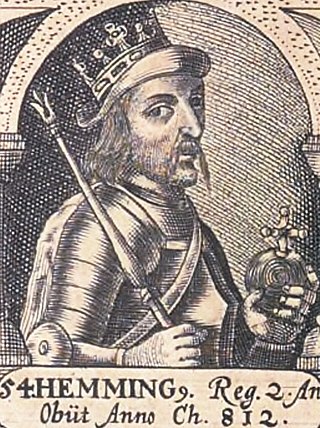
Hemming I was a king in Denmark from 810 until his death. He was the successor of King Gudfred, his uncle.

Great Moravia, or simply Moravia, was the first major state that was predominantly West Slavic to emerge in the area of Central Europe, possibly including territories which are today part of the Czech Republic, Slovakia, Hungary, Austria, Germany, Poland, Romania, Croatia, Serbia and Ukraine. The formations preceding it in these territories were the Samo's tribal union and the Pannonian Avar state.

The Northern March or North March was created out of the division of the vast Marca Geronis in 965. It initially comprised the northern third of the Marca and was part of the territorial organisation of areas conquered from the Wends. A Lutician rebellion in 983 reversed German control over the region until the establishment of the March of Brandenburg by Albert the Bear in the 12th century.

The Chronicle of Moissac is an anonymous compilation that was discovered in the abbey of Moissac, but is now thought to have been compiled in the Catalan monastery of Ripoll in the end of the tenth century. Like most chronicles, it begins with Adam, but gains increasing interest for historians as it nears its end date of 828. Unfortunately, a folio with the entries covering the years 716–770 is missing. The only surviving manuscript of the Chronicle of Moissac dates from the later 11th century and is now in the French National Library in Paris.

The Royal Frankish Annals, also called the Annales Laurissenses maiores, are a series of annals composed in Latin in the Carolingian Francia, recording year-by-year the state of the monarchy from 741 to 829. Their authorship is unknown, though Wilhelm von Giesebrecht suggested that Arno of Salzburg was the author of an early section surviving in the copy at Lorsch Abbey. The Annals are believed to have been composed in successive sections by different authors, and then compiled.
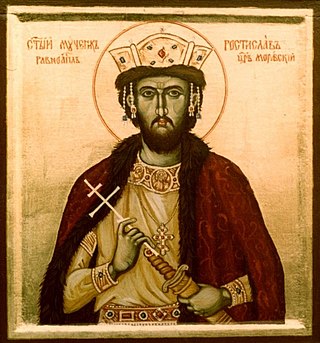
Rastislav or Rostislav, also known as St. Rastislav, was the second known ruler of Moravia (846–870). Although he started his reign as vassal to Louis the German, king of East Francia, he consolidated his rule to the extent that after 855 he was able to repel a series of Frankish attacks. Upon his initiative, brothers Cyril and Methodius, sent by the Byzantine Emperor Michael III in 863, translated the most important Christian liturgical books into Slavonic. Rastislav was dethroned by his nephew Svatopluk I of Moravia, who handed him over to the Franks. He was canonized by the Eastern Orthodox Church in 1994.

Mojmir I, Moimir I or Moymir I was the first known ruler of the Moravian Slavs (820s/830s–846) and eponym of the House of Mojmir. In modern scholarship, the creation of the early medieval state known as Great Moravia is attributed either to his or to his successors' expansionist policy. He was deposed in 846 by Louis the German, king of East Francia.
Morman was a Breton chieftain who was declared king (rex) after the death of the Bretons' Frankish overlord Charlemagne in 814. He is the first person known by name to be described as a Breton "king". He probably ruled a warband with members drawn from throughout Brittany. He had a stronghold defended by ditches, hedges and marshes.

Sigfred was an eighth century Danish king who is known to have reigned from before 777 to after 798. Fragments of his reign can be traced via Frankish sources.
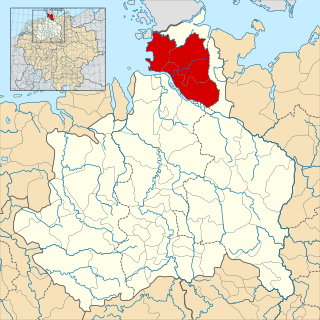
Nordalbingia was one of the four administrative regions of the medieval Duchy of Saxony, the others being Angria, Eastphalia, and Westphalia. The region's name is based on the Latin name Alba for the Elbe River and refers to an area predominantly located north of the Lower Elbe, roughly corresponding with the present-day Holstein region. Situated in what is now Northern Germany, this is the earliest known dominion of the Saxons.
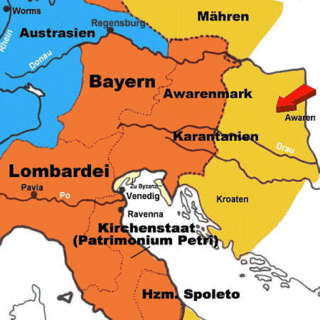
The Avar March was a southeastern frontier province of the Frankish Empire, established after successful Frankish campaigns and conquests of Avarian territories along the river Danube, to the east from the river Enns, in what is today Lower Austria and northwestern Hungary. Since the Frankish conquest in the late 8th century, there were several administrative changes in those regions. Territory along the river Danube, from the river Enns to the Vienna Woods, was ruled directly, as a frontier extension (march) of the Frankish Bavaria, while regions further to the east, up to the river Rába, were initially designated to remaining Avarian princes, under the Frankish supreme rule. During the 820s and 830s, additional administrative changes were made in the wider region of Frankish Pannonia, inhabited mainly by Pannonian Slavs. Territories of the remaining Avarian princes were fully incorporated, and Avars eventually disappeared from the region.
The Stellinga or Stellingabund was a movement of Saxon frilingi (freemen) and lazzi (freedmen) between 841 and 843. These were the middle two Saxon castes, below the nobility and above the unfree. The aim of the Stellinga was to recover those rights the two castes had possessed before their conversion from Germanic paganism in the 770s. At that time they had still possessed political privileges, but Charlemagne, having won over to his cause the Saxon nobility, had reduced them to mere peasants. The Stellinga thus despised the Lex Saxonum, which had been codified by Charlemagne, preferring to live in accordance with ancient and unwritten tribal custom. The movement was violently resisted by the uppermost caste, the nobiles (nobility), not always with the support of the Frankish kings.
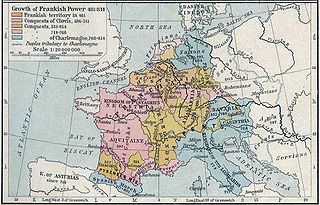
The siege of Trsat was a battle fought over possession of the town of Trsat in Liburnia, near the Croatian–Frankish border. The battle was fought in the autumn of 799 between the defending forces of Dalmatian Croatia under the leadership of Croatian duke Višeslav, and the invading Frankish army of the Carolingian Empire led by Eric of Friuli. The battle was a Croatian victory, and the Frankish commander Eric was killed during the siege.
Praedenecenti was an early medieval Slavic tribe, mentioned only in the Royal Frankish Annals in 822 and 824. They lived in the buffer zone between the Carolingian and Bulgarian empires. The Royal Frankish Annals associated them with the Abodriti, while modern scholars have also connected them to other Slavic tribes, especially the Braničevci or Merehani. The Praedenecenti sought assistance from the Franks against the Bulgars, but they obviously lost their independence because they were not mentioned after 824.
The Smeldingi were a small group of Polabian Slavs living on the border of the Old Saxony in the 9th century, probably between the Elbe and the Havel. They were a sub-group of the Hevelli. Their name is etymologically related that of the South Slavic Smolyani and the East Slavic city of Smolensk.
Lüne was a location on the left bank of the lower Elbe, known in connection with the Saxon war of 795. It was a village near Lüneburg.
The Linones were a small Slavic people first recorded in the early 9th century. They lived north and east of the Elbe, across from Höhbeck in the region around Lenzen, south of the Wilzi and Obotrites, north of the Hevelli and northeast of the Saxons. They may have been a sub-group of the Wilzi and were often under Obotrite control. They may be associated with the medieval Gau Liezizi.

The Chronicon universale usque ad annum 741 is an anonymous Latin chronicle from the creation of the world to AD 741. It was written in Francia, probably in Burgundy, between 741 and 775. It survives wholly or partially in at least six manuscripts.

The Chronicle of Aniane is an anonymous Latin history covering the rise of the Carolingian family from 670 to 840. It was composed by a monk of the Abbey of Aniane.

The Avar Wars were fought between Francia and the Avar Khaganate in Central Europe from 788 to 803, and ended with the Frankish conquest of the khaganate's western regions. The first conflicts between the Avars and the Franks occurred in the 560s, shortly before the Avar conquest of the Pannonian Basin. Armed conflicts between the two powers were not unusual during the following centuries.